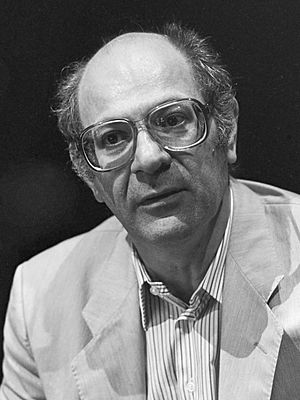Mauricio Kagel facts for kids
Mauricio Raúl Kagel (born December 24, 1931 – died September 18, 2008) was a famous composer and teacher. He was born in Argentina and later lived in Germany. Kagel was known for his very unique and often playful approach to music.
Contents
Life and Career
Early Life and Moving to Germany
Mauricio Raúl Kagel was born in Buenos Aires, Argentina, on December 24, 1931. His family had moved there from Russia. He studied music, history, and philosophy in Buenos Aires. In 1957, he moved to Cologne, West Germany. He lived there until he passed away.
Kagel as a Teacher
Kagel taught music at several places. He taught at the Darmstädter Ferienkurse for many years. He was also a visiting professor at the University at Buffalo in the United States. Kagel also taught at the Berlin Film and Television Academy. From 1974 to 1997, he was a professor at the Hochschule für Musik und Tanz Köln. He taught about new music theatre there. Many students learned from him, including Moya Henderson and Kevin Volans.
Kagel as a Composer
Mauricio Kagel was a very creative composer. Some of his music pieces gave special instructions to the performers. For example, they might be told to make certain faces or move in a specific way. This made his performances very theatrical. People sometimes compared his work to the "theatre of the absurd." He explored how music fits into society. Kagel also worked with film and photography. In 2000, he won the Ernst von Siemens Music Prize. This is a very important award for musicians.
His Music
Kagel's music often included unusual ideas. His work Staatstheater (1970) is one of his most famous pieces. He called it a "ballet for non-dancers." It was more like an opera. It even used everyday objects as musical instruments.
Another piece was a radio play called Ein Aufnahmezustand (1969). It was about making a radio play. In Con voce (With Voice), three masked performers pretended to play instruments silently. Match (1964) was like a "tennis game" for two cellists. A percussionist acted as the umpire. This piece was also made into one of Kagel's films.
Kagel also wrote many traditional orchestral and chamber pieces. These pieces often referred to music by famous composers like Beethoven and Bach.
His Films
Kagel also made films. One of his best-known films is Ludwig van (1970). This film looked at how people used the music of Ludwig van Beethoven. It was made during the 200th anniversary of Beethoven's birth.
In the film, you see a copy of Beethoven's music studio. Everything in the room is covered with Beethoven's sheet music. The film's soundtrack is a piano playing this music. Because the music is wrapped around things, it sounds a bit strange. But you can still hear Beethoven's tunes. The film also made fun of radio or TV shows about "Beethoven Year." Kagel later turned the film itself into a piece of sheet music. This meant it could be played in a concert without the film.
Images for kids
See also
 In Spanish: Mauricio Kagel para niños
In Spanish: Mauricio Kagel para niños



